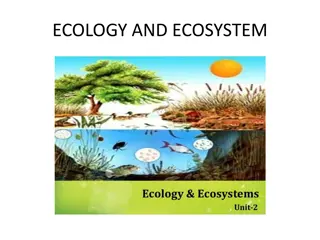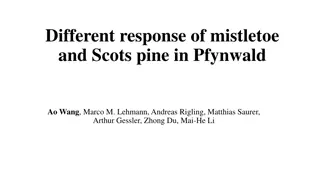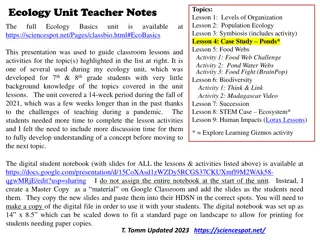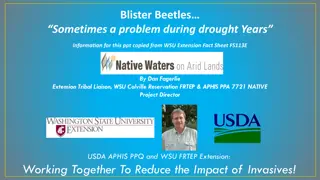Implications of Whitebark Pine Blister Rust on Treeline Ecology
Blister rust is impacting whitebark pine ecology at treeline locations, affecting community dynamics and response to climate change. Whitebark pine serves as a crucial nurse tree and tree island initiator in Rocky Mountain communities. The decline in whitebark pine due to blister rust disrupts its role, potentially altering treeline community responses to environmental shifts.
Download Presentation

Please find below an Image/Link to download the presentation.
The content on the website is provided AS IS for your information and personal use only. It may not be sold, licensed, or shared on other websites without obtaining consent from the author. Download presentation by click this link. If you encounter any issues during the download, it is possible that the publisher has removed the file from their server.
E N D
Presentation Transcript
Whitebark Pine Ecosystem Foundation, Whitebark Pine Science and Management Workshop, September 19, Coeur d Alene, Idaho Blister Rust Alters Whitebark Pine Ecology at Treeline: Implications for Treeline Response to Climate Change Diana F. Tomback,1 Lynn M. Resler,2 George P. Malanson,3 Emily K. Smith-McKenna,2 Sarah C. Blakeslee,1 Jill C. Pyatt1, and Aaron C. Wagner1 1University of Colorado Denver 2Virginia Tech University 3University of Iowa
Treeline environments Treeline environments are climatically harsh. Soils are often nutrient-poor and unstable. Facilitation between plant species, or a nurse object and a plant, may improve plant survival (e.g., Callaway et al. 2002, Brooker et al. 2007). These same processes are essential at the upper treeline limit, enabling communities to respond to climate warming.
Whitebark Pine (Pinus albicaulis) at Treeline Whitebark pine inhabits upper the subalpine and treeline zone throughout its distribution. It provides important ecosystem services and functions. Seeds dispersed to treeline by Clark s nutcrackers. In the alpine treeline ecotone (ATE), there is a mix of solitary krummholz trees and tree islands composed of two or more krummholz trees. Tree islands form when a solitary tree becomes established, and other trees establish leeward.
Tree establishment often occurs in protected locations leeward of: nurse objects nurse plants in microtopography, Lee of Salix Steps and risers
White pine blister rust and treeline dynamics In some Rocky Mountain communities, whitebark pine is an important nurse tree and tree island initiator. Most common forest associates are subalpine fir (Abies lasiocarpa) and Engelmann spruce (Picea engelmannii). White pine blister rust (pathogen = Cronartium ribicola) is present in all treeline communities examined. Whitebark pine mortality disrupts its role as a tree island initiator. This Impacts community development at and above treeline. Will declines in whitebark pine alter treeline community response to climate warming?
Where is whitebark pine a tree island initiator? Major initiator Study location Lat. N Standley Glacier, Kootenay NP, BC 51 11' Lee Ridge, Glacier NP, MT 48 55' Divide/White Calf Mountains, Glacier NP, MT 48 40' Line Creek RNA, Custer NF, MT 45 02' Not major initiator Willmore Wilderness Park, AB 53 46' Parker Ridge, Banff NP, AB 52 10' Gibbon Pass, Banff N P, AB 51 11' Tibb's Butte, Shoshone NF, MT Resler et al. 2014, Tomback et al. 2014, Tomback and Resler, in prep 44 56'
Why is whitebark pine a majority tree island initiator in some areas? Hypothesis Whitebark pine s prevalence as a tree island initiator is correlated to its relative abundance as a solitary tree.
Is whitebark pines prevalence as a tree island initiator proportional to its relative abundance as a solitary tree? NO. But it is generally abundant. 0.8 Solitary trees Tree island initiators 0.7 0.6 0.5 0.4 0.3 0.2 0.1 0 Tibb's Butte White Calf Divide Mtn Lee Ridge Standley Glacier Gibbon Pass Parker Ridge Willmore Tomback et al. 2014, Resler et al. 2013; Tomback & Resler in prep.
Regression analysis Spearman rank correlation: 0.2619, n = 8, P = 0.501
Why is whitebark pine so abundant within climatically harsh treeline communities? Hypothesis: Whitebark pine has greater hardiness under harsh treeline conditions: We compared hardiness among whitebark pine, Engelmann spruce, and subalpine fir. We defined hardiness in three ways: Qualitative assessment of vigor. Requirements for a protective microsite. Annual shoot length, reflecting carbon acquisition and allocation.
Primary study areas Research from 2006 through 2014. Divide/White Calf Mountains--Glacier National Park and Blackfeet Tribal Land, MT--elevation ca. 2,200 m. Line Creek Research Natural Area, Custer National Forest, Beartooth Plateau, MT--elevation ca. 2,950 m.
Relative hardiness 1) Qualitative assessment of vigor (1 to 4 = best), based on: windward needle death, condition of new shoots, and needle color. Divide Mtn. Whitebark pine had significantly higher vigor than both fir and spruce (Kruskal-Wallis, 2 = 18.9, df = 2, P = 7.8e-5, post hoc W = 19557, P = 0.037,post hoc, W = 13026.5, P = 2.08e-5) Line Creek No differences. 2) Association of solitary trees with a protective microsite. At both Divide Mtn. and Line Creek, fewer whitebark pine were associated with a protective microsite than fir or spruce. ( 2 = 9.769, df = 2, P = 0.008, 2 = 11.3217, df = 2, P = 0.003) Blakeslee et al., 2012, MS.
Shoot lengthsbootstrapped 95% confidence intervals (Blakeslee et al. in prep., Wagner) Whitebark Pine Subalpine Fir Engelmann Spruce Divide Mountain Line Creek RNA 17 21 15 12 15 20
Why is whitebark pine a majority tree island initiator? Hypotheses Whitebark pine offers greater microsite protection than other conifer species.
Does whitebark pine offer better leeward protection than associated conifers? Measured 11 biophysical variables leeward of four common treeline microsites: whitebark pine, Engelmann spruce, rock, and unprotected microsite. Air & soil temp., soil moisture, wind speed & gusts, PAR. Soil for total carbon and nitrogen; leeward sky exposure. Pyatt 2013; Pyatt et al, MS.
Microclimate and microsite: summary Compared to rock and open microsites, leeward conifer microsites had more favorable microclimates: Reduced maximum air and soil temperatures. Higher minimum soil temperatures. Lower PAR. Reduced wind and gust speeds. Whitebark pine microsites and spruce microsites offered similarly protective microclimates. No statistical difference in soil C and N. BUT, whitebark pine had significantly lower sky exposure in leeward microsites in comparison with subalpine fir, rock, and open sites (Boggs, Bevency Kruskall-Wallis, n = 8, R = 48.61, P =0.000).
Whitebark pine offers leeward protection Pyatt 2013
Is facilitation really occurring? Simulating the impact of blister rust In 2010, we selected 22 control and 22 experimental dyads on Divide/White Calf Mtn. Dyad = windward whitebark pine; leeward spruce or fir. We girdled and defoliated the experimental windward whitebark pine in 2010. Note: all experimental whitebark pine were infected by blister rust. We measured shoot lengths on leeward conifers in 2010, 2011, and 2012. Blakeslee 2012; Blakeslee et al. MS.
Leeward conifer shoot lengths bootstrapped 95% confidence intervals (Blakeslee et al. MS., Wagner)
Is facilitation occurring? seeds and seedlings We examined survival rates of planted seedlings and the germination rates of sown seeds among four leeward microsites: whitebark pine, spruce, rock, and open. Divide Mtn. sowed spruce seeds and planted fir seedlings. Line Creek sowed spruce seeds and planted spruce seedlings. 20 replicates for each microsite type for seedlings and for seeds. (Blakeslee 2012; Blakeslee et al. in prep)
Facilitation: seeds and seedlings Seedlings Divide Mtn. 90% mortality of fir seedlings. Line Creek 63.1% mortality of spruce seedlings. No significant differences in seedling survival among microsite types at Divide Mountain or Line Creek RNA. Seeds Divide Mtn. 20% of fir seeds germinated. Higher than expected germination occurred in rock microsites and fewer than expected in whitebark microsites (Fisher s Exact Test, P = 0.01). On Divide, 42 out of 80 germinants survived to September. Line Creek 1.8% of spruce seeds germinated. No differences among microsites.
Divide Mtn. Summer survival of seedlings Comparison of observed vs. expected cotyledon seedling survival among microsites. --Seedlings in whitebark microsites had a 5.7 times greater than expected survival advantage over the summer. --Very low comparative risk of death (0.18 times expected). Microsite Relative Survival Advantage Relative Risk of Death 5.70 0.18 Whitebark 0.89 1.12 Spruce 1.08 0.93 Rock 0.64 1.56 Open
Blister rust at treeline Intensive sampling using 15 m x 15 m plots indicates widespread blister rust infection: Divide Mountain, 23.6% Line Creek RNA, 19.2% Previous sampling at six other treeline sites in Glacier NP (15 x 15 m plots): Infection rates of 36-96%. Overall infection rate of 47%. (Smith-McKenna et al. 2011; Smith- McKenna 2013)
Will declines in whitebark pine alter treeline response to climate warming? Blister rust damages and kills whitebark pine at treeline Fewer seeds dispersed to treeline by nutcrackers: blister rust in subalpine whitebark pine Decline in treeline whitebark pine Whitebark pine shows little or no response to global warming in upper treeline boundary Fewer tree islands initiated by whitebark pine (less facilitation) Reduced ability of treeline to respond (or lag in response time) to global warming at the upper boundary
Agent Based Models: climate and blister rust Smith-McKenna et al., in press In the Climate scenario, both pine and spruce agents increased when conditions improved, and trees advanced to higher elevations into previous tundra cells. This scenario increased whitebark pine numbers by 28.8%. Both pine and spruce populations increased as tundra concurrently declined. In the Climate+Disease scenario, mortality from blister rust reduced pine populations despite improved site quality conditions. Both spruce populations and tundra increased. The threshold of change from dominating pine agents to spruce appeared around year 630.
Agent Based Model preliminary results Smith-McKenna et al., in press 3) Climate Ameliorated Treeline 9000 8000 7000 Population 6000 5) Accelerated Climate+Diseased Treeline 5000 9000 Tundra 4000 Pine Agents Tundra 8000 3000 Spruce Agents 7000 2000 Population 6000 1000 Pine Agents 0 5000 500 550 600 Simulated Years 650 700 750 800 4000 Spruce Agents 3000 2000 4) Climate+Diseased Treeline 1000 Infected Pine Agents 9000 0 8000 500 550 600 650 700 750 800 7000 Simulated Years Population 6000 Tundra 5000 Pine Agents 4000 Spruce Agents 3000 2000 Infected Pine Agents 1000 0 500 550 600 Simulated Years 650 700 750 800
Conclusion Our collective studies suggest: Whitebark pine tolerates harsh treeline better than associated conifers. It provides protective leeward microsites. Whitebark pine decline from blister rust will delay or impede treeline response to climate warming. Postscript What are possible reasons why whitebark pine is not a majority tree island initiator in some regions? Cold, snowy sites support more spruce and fir than whitebark pine. Whitebark tolerates the harshest exposed sites and ridgelines.
Postscript 1 Willmore Wilderness Park 0.9 0.8 0.7 0.6 Solitary trees 0.5 Tree island initiators 0.4 0.3 0.2 0.1 0 Fetherstonaugh Smoky River Hardscrabble
ACKNOWLEDGMENTS Field assistance: Libby Pansing, Sol Diaz, Kodi Augare. Logistics: Glacier National Park (thanks to Tara Carolin) Blackfeet Nation (thanks to Mark Magee) Shoshone and Custer National Forests (thanks to Ken Houston) Rocky Mountain Research Station, Ft. Collins Financial Support: National Science Foundation, Geography Program: L. Resler, D. Tomback, and G. Malanson NSF BCS-0850548























